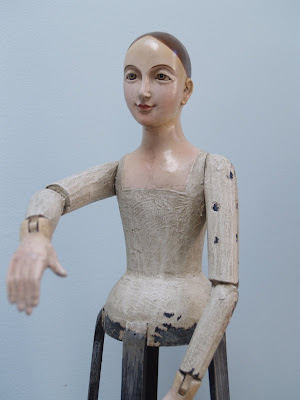 Dress c 1690 (Note the profusion of lace trimmings and the lace lappets).Lace is said to have originated in Venice in the 1300s.
Dress c 1690 (Note the profusion of lace trimmings and the lace lappets).Lace is said to have originated in Venice in the 1300s. Over time, centres of lace-making developed in other parts of Europe including Flanders, Dresden and France.
Designs of early bobbin and needle laces have a strong resemblance to one another due to the creation of pattern books, which were disseminated throughout Europe. The earliest lace pattern book is believed to be from 1524.
Making lace was a labour-intensive process. For example,
a pair of men's ruffles made of Valenciennes lace (a type of bobbin lace with the motifs outlined by small pin holes) might take "10 months to produce, based on a 15-hour working day". Not surprisingly, lace was extremely costly.
As the dictates of fashion in the seventeenth century proscribed lace cuffs, ruffs, collars, and trimmings,
the demand for Venitian lace (as well as lace from Flanders) resulted in a huge amount of capital flowing out of France. Louis XIV's brilliant finance minister, Colbert, authorized significant investment in a French lace-making industry in Normandy. This site may have been chosen because there was already the beginnings of a lace and braid industry in the Duchy of Alencon.
In 1665, a Royal Ordinance established the manufacture of Points de France with
an exclusive right to supply the French Court.In 1667, the sale or wearing of Venetian lace or any other foreign lace was prohibited in France.This prohibition was taken very seriously and
foreign laces were publicly burned. In 1670, R. Montague said: "
They are so set in this country upon maintaining their own manufactures that only two days ago there was publicly burnt by the hangman a hundred thousand crowns worth of point de Venise, Flanders lace and other commodities that are forbid."Initially, the French copied Italian lace designs. With the high level of Royal patronage, the centres of Alencon and Argentan eventually developed their own styles and characteristics. Alencon often has a horsehair stiffening for the picots (loops) which meant that it was more often used in winter when humidity swelled and stiffened the horsehair. Argentella uses hexagonal mesh, each side of which is worked with buttonhole stitches.
After the French Revolution and the banning of ruffles in 1794, production fell dramatically. Alencon lace continued to be produced in the 19th century.
In May, I will be visiting Normandy, specifically the the
Musée Baron Gérard which has an impressive collection of the local lace in both bobbin and needle technique dating back to the 18th century. The collection has household items (tablecloths, doilies, pillows, curtains, bedspreads) as well as garments (infant Christening gowns, wedding veils, dresses and blouses).

 Yesterday while poking around a vintage shop on Queen Street, I came across this antique doll on a stand. Unfortunately, the owner of the store could not tell me anything about its history. The doll is about 2 feet tall and has a beautifully painted face and articulated joints in the arms.
Yesterday while poking around a vintage shop on Queen Street, I came across this antique doll on a stand. Unfortunately, the owner of the store could not tell me anything about its history. The doll is about 2 feet tall and has a beautifully painted face and articulated joints in the arms.
































